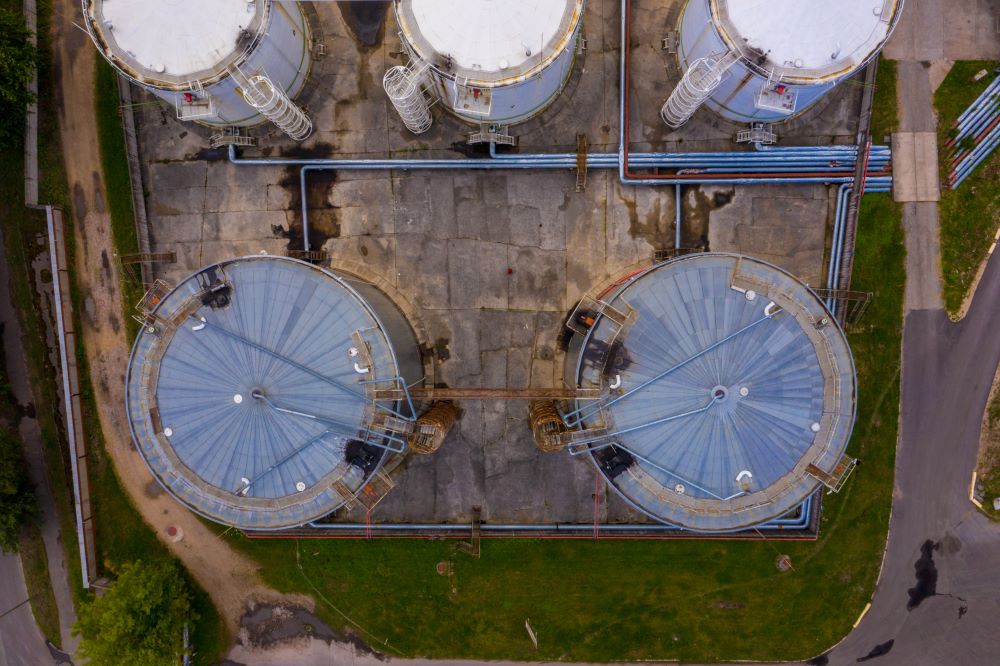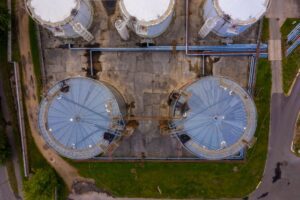As an industrial storage tank owner, maintaining the integrity and safety of your tanks is critical. One of the most effective ways to maximize storage capacity while reducing emissions is to install an internal floating roof. Aluminum internal floating roofs, in particular, provide an affordable and durable solution. However, to realize their full benefits, they must be properly installed and maintained.
This article provides a comprehensive guide for installing and maintaining aluminum internal floating roof in your storage tank. You will learn how to select an appropriate roof design based on your specific tank dimensions and stored product. Detailed installation instructions cover securing the roof to the tank wall, installing seals and rim fittings, and testing for proper operation. To keep your aluminum internal floating roof functioning safely and efficiently over its lifetime, regular inspections and preventative maintenance must tank be performed. Specific procedures for inspecting roof seals, adjusting rim fittings, and repairing any damage are described.
By following the best practices in this guide, you can maximize the service life of your aluminum internal floating roof and ensure safe, compliant operations. Keep your storage tanks in top working condition and avoid costly downtime or regulatory penalties by installing and maintaining aluminum internal floating roofs according to these recommendations.
What Are Aluminum Internal Floating Roofs?
Aluminum internal floating roofs (IFRs) are pontoon-type roofs used in fixed-roof tank to reduce vapor space and emissions. An IFR floats directly on the liquid surface, rising and falling with the level changes. IFRs are designed to minimize the amount of air and vapor trapped above the floating roof.
There are two main types of IFRs:
- Single-deck IFRs have a solid deck covering the entire area within the tank. They provide maximum vapor control but can be difficult to install and maintain.
- Double-deck IFRs have an upper and lower deck with a seal around the edge and in the center. The design reduces deck weight and makes installation and maintenance easier while still achieving good vapor control.
IFRs require routine inspections and seal replacements to function properly. As liquid levels change, the seals must continue to contain vapors below the deck. Over time, seals can degrade and fail if not properly maintained.
To install an IFR, the tank must be thoroughly cleaned, inspected, and repaired as needed. The IFR components are assembled and seals installed before the deck is floated into place. Care must be taken not to damage the seals or deck during installation. Once installed, routine inspections should check for damage, leaks, or failing seals requiring repair or replacement.
With proper installation and maintenance, aluminum IFRs can provide effective long-term emission control and environmental compliance for fixed-roof tanks. Regular inspections and quick action when needed will help maximize the benefits these roofs offer.
Benefits of Using Aluminum Internal Floating Roofs
Installing aluminum internal floating roofs (IFRs) in storage tanks provides many benefits. IFRs help reduce emissions, conserve product, and lower costs
Reduced Emissions
Aluminum IFRs create an effective vapor barrier, preventing the escape of hydrocarbons into the atmosphere. This cuts down on emissions and helps companies meet environmental regulations. The aluminum material is also non-reactive, preventing contamination of the stored product.
Product Conservation
An aluminum IFR minimizes product loss from evaporation and oxidation by eliminating headspace within the tank. This can save companies thousands of gallons of product each year, increasing the bottom line. The aluminum sheets that make up the IFR also do not rust or corrode, which prevents contamination of the stored liquid.
Cost Savings
Although aluminum IFRs have a higher upfront cost than some alternatives, they pay for themselves over time through product conservation and reduced maintenance. Aluminum IFRs have a lifespan of 30-40 years, do not require frequent recoating or replacement, and minimize the need for vapor recovery systems. The non-reactive and non-corrosive nature of aluminum also prevents damage to the tank’s primary steel shell, saving money by avoiding costly repairs or tank replacement.
Installing an aluminum IFR is an investment that provides both environmental and economic benefits. With options for both new tank construction and retrofitting existing tanks, aluminum IFRs present an opportunity for companies to cut costs, increase sustainability, and ensure regulatory compliance. By reducing emissions, conserving product, and lowering expenses, aluminum IFRs quickly become a financially strategic choice.
Step-by-Step Guide to Installing Aluminum Internal Floating Roofs
Installing an aluminum internal floating roof is a multi-step process that requires precision and care. To properly install an aluminum internal floating roof, follow these steps:
Inspect the Tank
Prior to installation, inspect the tank to ensure it is clean and ready. Check that the tank foundation is level, the shell is round, all fittings are installed, and there are no protrusions that could damage the floating roof.
Assemble Roof Panels
Assemble the aluminum roof panels and all accessories on the tank floor or a smooth, clean surface according to the manufacturer’s instructions. Connect the panels with the provided splice plates and bolts to form a continuous surface.
Install Guide Poles
Space guide poles around the tank perimeter according to the manufacturer’s specifications. Guide poles prevent the floating roof from shifting off-center. Secure the base plate of each guide pole to the tank floor.
Lift and Place Roof
Use a crane to slowly lift the assembled aluminum internal floating roof and place it on the tank floor, guiding it onto the guide poles. Ensure the roof is level for proper functioning.
Connect Roof to Guide Poles
Attach the roof to each guide pole using pole sleeves and bolts. The sleeves allow vertical movement of the roof along the guide pole. Tighten all bolts securely.
Test and Seal
Test that the floating roof can move up and down freely along the guide poles. Inspect and seal any joints or seams to ensure an airtight and liquid-tight seal before filling the tank.
Fill and Empty Tank
Slowly fill the tank while checking that the floating roof rises evenly and seals properly against the tank wall. Once full, empty and re-check all connections before putting the tank into service.
Following these steps carefully will ensure a properly installed and functioning aluminum internal floating roof. Routine inspections and maintenance will maximize the service life of the floating roof.
Maintenance Tips for Aluminum Internal Floating Roofs
To ensure optimal performance and longevity of your aluminum internal floating roof, regular inspections and maintenance are required. Routine maintenance will help identify any issues early on and prevent costly repairs down the road.
Conduct routine visual inspections of the floating roof at least once per month. Check for signs of corrosion, dents, or damage to the roof panels, seals, or supports. Inspect the roof vents and rim seals for tears or gaps. Note any needed repairs and perform them promptly.
Inspect the legs and supports of the floating roof. Ensure legs are vertically aligned and securely fastened to the tank floor. Tighten any loose nuts or bolts. Replace severely corroded or damaged supports.
Examine the guide poles and stilling well around penetrations like ladders for signs of damage or buildup. Clean and lubricate guide poles regularly per the manufacturer’s recommendations.
Inspect primary and secondary rim seals for damage or degradation. Replace rim seals if there are visible tears, gaps, or signs of leakage. Rim seals prevent vapor loss and maintain proper roof buoyancy.
Drain any standing water from the internal floating roof periodically. Water buildup adds excessive weight and can damage the floating roof or rim seals.
Once every 3-5 years, it is a good idea to hire a certified professional to perform a comprehensive internal inspection and service of your floating roof. They can fully assess the condition, test critical components, and perform necessary repairs to maximize the lifetime of your aluminum internal floating roof.
Following these best practices for maintenance and regular inspections will help reduce unplanned downtime, ensure safe operating conditions, improve sustainability, and prolong the service life of your aluminum internal floating roof.
What maintenance is required for an AIFR?
AIFRs require periodic inspections and maintenance to ensure proper function. The sealant between panels should be checked regularly and reapplied as needed. Guide wires and counterweights must be inspected and calibrated to confirm the AIFR is floating at the proper level. The AIFR panels themselves may require minor repairs or patching over time.
Major maintenance, such as replacing damaged panels or renovating the sealant across the entire AIFR, typically requires draining and cleaning the tank. Most AIFR systems require overhaul maintenance every 10-15 years, depending on use and product stored. Regular maintenance helps maximize the benefits of an AIFR and ensures safe, efficient long-term operation.
Conclusion
In closing, following the steps outlined to properly install and maintain aluminum internal floating roofs will help you achieve optimal performance and a long service life from these systems. Regular inspections and maintenance are key to success. Be sure to check seals, adjust or repair components as needed, remove built-up sludge and residue, and test all mechanisms to ensure everything is functioning properly. When done correctly and consistently, aluminum internal floating roofs can provide an efficient and cost-effective solution for volatile organic compound emissions control and loss prevention. You have the power to implement best practices and reap the benefits of this investment for years to come through diligent care and upkeep. The effort will be well worth it.




